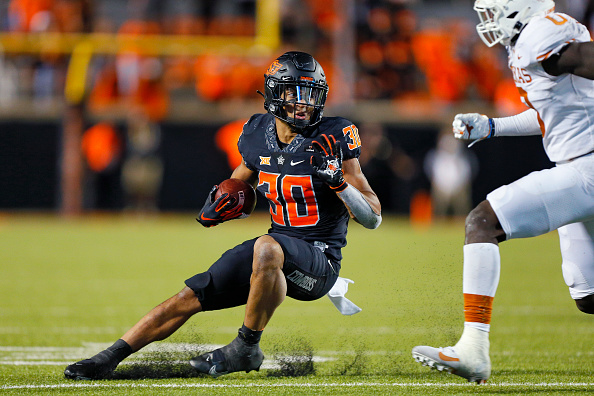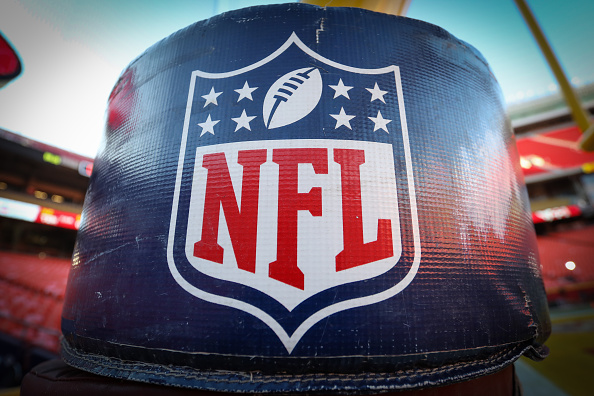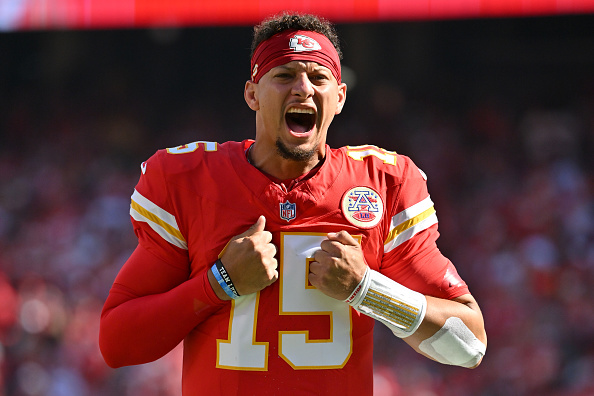After a terrific 2019 season that included an FBS leading 2,094 rushing yards and 21 rushing touchdowns, Chuba Hubbard decided to play in 2020 despite the option to opt-out because of Covid-19 and prepare for the draft. However, after suffering an ankle injury halfway through the season, Hubbard ended his Oklahoma State career and declared for the 2021 NFL Draft. The question remains: was Hubbard’s 2019 season a sign of things to come in the NFL or a fluke playing against a bunch of terrible Big 12 defenses. Let’s dive into it.
Make sure to check out all of our other 2021 NFL Draft Scouting Reports.
Player Bio
Name: Chuba Hubbard
Jersey: #30
Position: Running Back
School: Oklahoma State
Class: Junior
Height: 6’0”
Weight: 210lbs
Speed (10.17/15)
Hubbard lacks breakaway speed. Defenders repeatedly were able to get their hands on him before he could pull away. Furthermore, Hubbard struggled when running sideline to sideline. When he had momentum running North-South, he could outrun average defenders. However, in the NFL, where everyone is fast, Hubbard will struggle to break off big runs unless defenders take poor tackling angles.
Patience/Vision (13.42/15)
This trait is easily Hubbard’s biggest strength. He is a patient runner who can sit and wait for holes to open. Sometimes he would wait too long and be forced to dive forward for whatever yards he could get. However, that was more a rarity than the norm. When Hubbard had the chance to read the blocks and attack, he would typically find the correct hole to hit and do it before the defense even know it was open. When Hubbard got forced outside, he would instead cut back at times despite no clear lane due to his lack of burst.
Breaking Tackles (10.17/15)
Despite his 6’0” 210 lb frame and tough running style, Hubbard was tackled on first contact way too often in the games watched. More importantly, he would get tripped up by ankle tackles instead of maintaining his balance. Furthermore, Hubbard lacks the quickness to set defenders up in space. Instead, he would typically try to run away from them. Even when he would lower his pads and initiate contact, Hubbard ended up on the ground most of the time.
Acceleration/Burst (5.58/10)
As mentioned before, Hubbard isn’t a fan of attacking the edge and getting outside the tackle box. The reason why is he lacks acceleration. Hubbard is a short stride runner and needs several steps to build up speed, especially when heading towards the edge. When running downhill, he tends to have more success building up speed, but still not enough to run away from faster defenders.
Change of Direction/Quickness (7.17/10)
When Hubbard goes to change direction, it’s not a quick process. He tends to really sink his hips and then lean towards the new direction. Sometimes, a part of that slow process is reading the offensive line and finding the cutback lane. However, other times it’s just a function of his tight lower body. The good news for Hubbard is when he changes direction, he doesn’t lose much momentum in his speed.
Contact Balance (6.33/10)
With his size and running style, you would think Hubbard succeeds with contact balance. However, he ends up on the ground too often on first contact. Whether it’s by an ankle tackle or bumping into a teammate, Hubbard struggles to keep his balance and move forward. On fourth and one against Texas in 2019, the Oklahoma State right guard got pushed back at the snap. This caused him to bump into Hubbard very shortly after taking the handoff. Despite a clear lane to gain the first down, the bump caused Hubbard to lose his balance and fall to the ground, failing to pick up the yard needed for the first down. If Hubbard is going to succeed in the NFL, he needs to improve his balance.
Receiving Ability (5.25/10)
In his Oklahoma State career, Hubbard averaged 1.6 catches per game. He never had more than 23 in a season and had only three career receiving touchdowns. In the games watched, Hubbard struggled to make simple check down catches. Instead of using his hands and coming to the ball, Hubbard would allow it to hit him in the chest, using his body to secure the catch. When he couldn’t use his body to secure the ball, Hubbard clearly didn’t trust his hands and struggled to consistently make the catch.
Strength (2.83/5)
While Hubbard is a tough runner and fights every snap, he lacks the lower body strength to power through defenders. Several times in the games watched, Hubbard struggled to grind out the next yard needed. Hubbard needs to improve in this area if he wants to earn a consistent role in the NFL.
Short Yardage Situations (2.92/5)
The biggest reason why Hubbard needs to improve his strength is for short-yardage situations. He struggles to get penetration in tight spaces due to a lack of burst and lower body power. Hubbard struggles to grind out the needed yards at times. However, with a dominant offensive line, Hubbard can be effective in this area.
Pass Protection (1.25/5)
Without a doubt, this is Hubbard’s biggest flaw entering the draft. While he wasn’t afraid to get in the way of a blitzing defender, Hubbard usually just threw his body at the defender’s legs and hoped for the best. Once in a while, Hubbard will try to square up and get into the defender’s chest. However, those snaps rarely resulted in much success in Hubbard anchoring and holding his ground. Furthermore, Hubbard struggled to see late blitzers and where to help. After a play-action fake, Hubbard would stand flat and not have his head on a swivel looking for someone to block. Several times in the games watched, Hubbard would be unaware of his quarterback getting sacked despite not engaged blocking a defender.
Player Summary
Overall, Hubbard lacks the physical tools to turn into a three-down back in the NFL. Furthermore, his lack of success in short-yardage situations and the passing game limits his value to NFL teams. However, his vision and success when running downhill will appeal to several talent evaluators. Ideally, the best spot for Hubbard is to land in a running back by committee situation. This way, he can be used on early downs with a third-down back and power back available to handle the passing and short-yardage roles. In this situation, Hubbard could use his biggest strength (vision) while being protected from his biggest flaws (passing game duties).
Final Grade (65.09/100): Fifth-Round Pick
Player Comp: Jeff Wilson
Check us out on our socials:
Twitter: @PTSTNews and @TalkPrimeTime
Facebook Page: Prime Time Sports Talk
Join our Facebook Group: Prime Time Sports Talk
Instagram: @ptsportstalk
Follow Mike Fanelli on Twitter @Mike_NFL2
Main Image Credit:
Embed from Getty Images






